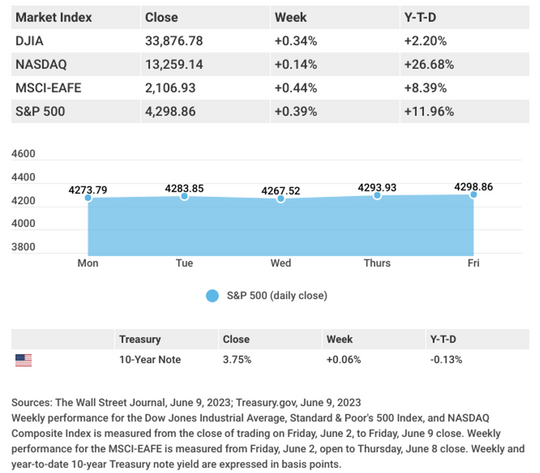|
A late-week rally sent stocks into positive territory, with the S&P 500 index closing just shy of the 4,300 mark. The Dow Jones Industrial Average gained 0.34%, while the Standard & Poor’s 500 added 0.39%. The Nasdaq Composite index improved 0.14% for the week. The MSCI EAFE index, which tracks developed overseas stock markets, rose 0.44%.1,2,3 |
 |
 |
Stocks Edge HigherStocks bumped along the flatline for much of the week ahead of this week’s two inflation reports and the June meeting of the Federal Open Market Committee. Amid little news, stocks drifted lower to start the week until Wednesday, when a solid early-day rally evaporated on news of the Bank of Canada’s surprise interest rate hike. Stocks rose again the following day, holding onto their gains, with the S&P 500 hitting a new closing high for 2023.4 Stocks added small gains on Friday after weathering some midday weakness, leaving major indices marginally higher for the week. Better BreadthOne investor concern has been that a handful of mega-cap stocks have driven recent market returns. Last week’s market bucked that trend, with outperformance in small-cap stocks and equally-weighted stock market indices. For instance, the Russell 2000 index (which measures the performance of 2,000 smaller-cap companies) rose 1.90% this week, outpacing the S&P 500 and the technology-heavy Nasdaq.5 Another example of broadening performance was the outperformance of the equally-weighted S&P 500 index, where each stock has equal weighting regardless of size, versus the market-cap S&P 500 index, where mega-cap companies disproportionately impact index performance. Last week’s return of the equally-weighted S&P 500 index exceeded the cap-weighted S&P 500’s return by 0.65%.6 This Week: Key Economic DataTuesday: Consumer Price Index (CPI). Wednesday: Producer Price Index (PPI). FOMC Announcement. Thursday: Retail Sales. Industrial Production. Jobless Claims. Friday: Consumer Sentiment. Source: Econoday, June 9, 2023 This Week: Companies Reporting EarningsMonday: Oracle Corporation (ORCL). Thursday: Adobe, Inc. (ADBE). Source: Zacks, June 9, 2023 |
 |
|
“I don’t believe in being serious about anything. I think life is too serious to be taken seriously.” – Ray Bradbury |
 |
Do You Know The Difference Between Taxable And Nontaxable Income?All income you receive is taxable unless the rules explicitly state it isn’t. According to the Internal Revenue Service (IRS), taxable income includes earned income like wages and any income earned by providing a service or the exchange of property or services. Rental income, interest, dividends, and social security benefits are all examples of taxable unearned income. Some income is only taxable if certain conditions are met. For example, life insurance proceeds are usually not taxable to the beneficiary unless you redeem a life insurance policy for cash. Any amount you receive above the cost of the policy is taxable. State and local income tax refunds may be taxable and should be reported on your federal taxes. Some forms of income are usually not taxable, like:
Several factors will affect the cost and availability of life insurance, including age, health, and the type and amount of insurance purchased. Life insurance policies have expenses, including mortality and other charges. If a policy is surrendered prematurely, the policyholder also may pay surrender charges and have income tax implications. You should consider determining whether you are insurable before implementing a strategy involving life insurance. Any guarantees associated with a policy are dependent on the ability of the issuing insurance company to continue making claim payments.
|
 |
Choose To Make Your Plate “MyPlate”The so-called Food Pyramid had many flaws. Its significant weaknesses were that it generalized recommended daily servings and poorly defined portion sizes. So, in 2008, the U.S. Department of Agriculture implemented a user-friendly redesign: the pyramid was transformed into a plate. The concept behind the MyPlate design was both revolutionary and seemingly obvious. After all, we eat off a plate, not a pyramid. Portions are easier to see. Make half the plate fruits and vegetables; the other half, grains and protein—a serving of dairy (or non-dairy alternative) on the side. Take advantage of this method the next time you sit down for a meal and see what adjustments you can make to make your plate even healthier.
|
 |
|
A common English word refers to a person or thing not being in a place. But just by inserting a space within it, you can get two words meaning that a person or thing is present. What is this word?
Last week’s riddle: A friend wants change for a dollar. All you have in your pocket are over a dollar in coins, but you still can’t make the change correctly. What is the largest amount of money you could have in this situation? What coins do you have that prevent you from making the change correctly? Answer: $1.19. Four pennies, four dimes, and three quarters. |
 |
 |
|
Hallstatter Lake, Hallstatt, Austria |
|
|
Footnotes And Sources
2. The Wall Street Journal, June 9, 2023. 3. The Wall Street Journal, June 9, 2023. 4. CNBC, June 8, 2023. 5. The Wall Street Journal, June 8, 2023. 6. Google Finance, June 9, 2023. 7. IRS.gov, November 10, 2022. 8. MyPlate.gov, February 15, 2023. |